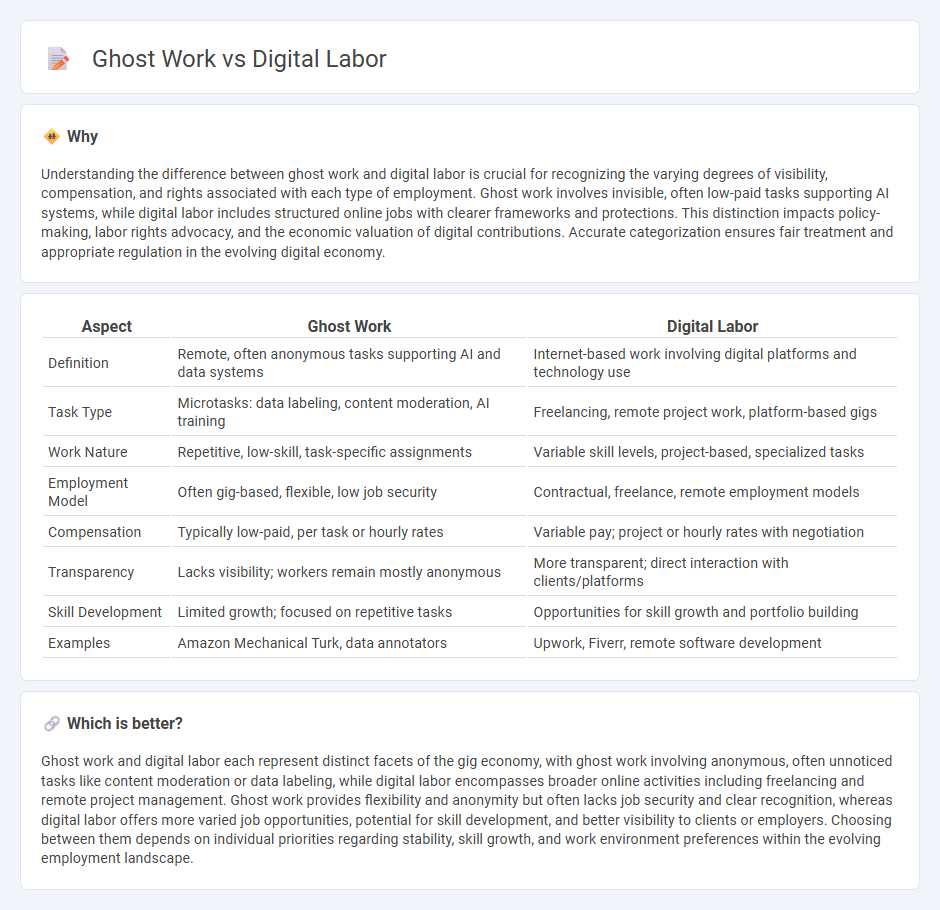
Ghost work refers to tasks completed by remote workers invisibly supporting digital platforms, often involving repetitive, low-paid assignments such as content moderation or data tagging. Digital labor encompasses a broader spectrum of online work, including gig economy jobs, freelance projects, and automated processes powered by artificial intelligence. Explore these evolving employment forms to understand their impact on the future of work.
Why it is important
Understanding the difference between ghost work and digital labor is crucial for recognizing the varying degrees of visibility, compensation, and rights associated with each type of employment. Ghost work involves invisible, often low-paid tasks supporting AI systems, while digital labor includes structured online jobs with clearer frameworks and protections. This distinction impacts policy-making, labor rights advocacy, and the economic valuation of digital contributions. Accurate categorization ensures fair treatment and appropriate regulation in the evolving digital economy.
Comparison Table
| Aspect | Ghost Work | Digital Labor |
|---|---|---|
| Definition | Remote, often anonymous tasks supporting AI and data systems | Internet-based work involving digital platforms and technology use |
| Task Type | Microtasks: data labeling, content moderation, AI training | Freelancing, remote project work, platform-based gigs |
| Work Nature | Repetitive, low-skill, task-specific assignments | Variable skill levels, project-based, specialized tasks |
| Employment Model | Often gig-based, flexible, low job security | Contractual, freelance, remote employment models |
| Compensation | Typically low-paid, per task or hourly rates | Variable pay; project or hourly rates with negotiation |
| Transparency | Lacks visibility; workers remain mostly anonymous | More transparent; direct interaction with clients/platforms |
| Skill Development | Limited growth; focused on repetitive tasks | Opportunities for skill growth and portfolio building |
| Examples | Amazon Mechanical Turk, data annotators | Upwork, Fiverr, remote software development |
Which is better?
Ghost work and digital labor each represent distinct facets of the gig economy, with ghost work involving anonymous, often unnoticed tasks like content moderation or data labeling, while digital labor encompasses broader online activities including freelancing and remote project management. Ghost work provides flexibility and anonymity but often lacks job security and clear recognition, whereas digital labor offers more varied job opportunities, potential for skill development, and better visibility to clients or employers. Choosing between them depends on individual priorities regarding stability, skill growth, and work environment preferences within the evolving employment landscape.
Connection
Ghost work and digital labor are interconnected through the reliance on human intelligence tasks performed remotely via online platforms. These tasks, often invisible and undervalued, include data annotation, content moderation, and micro-tasks essential for training artificial intelligence systems. The growth of digital labor markets has expanded ghost work, highlighting challenges in job security, fair wages, and labor rights for gig economy workers.
Key Terms
Platform Work
Digital labor on platforms involves algorithmically coordinated tasks performed by workers worldwide, while ghost work refers to often invisible, low-paid activities that support AI systems and digital services behind the scenes. Both forms highlight the growing gig economy's reliance on human input for platform efficiency and the challenges of labor rights and transparency in these decentralized environments. Explore the evolving dynamics of platform work to understand its implications on the future of digital labor and ghost work.
Algorithmic Management
Algorithmic management in digital labor leverages AI systems to monitor, evaluate, and direct workers, creating efficient yet often opaque work environments. In ghost work, human laborers perform tasks that train and refine these algorithms, operating behind the scenes without recognition or clear visibility. Explore how algorithmic management shapes the power dynamics and ethical implications in both digital labor and ghost work.
Invisible Tasks
Digital labor encompasses visible online tasks performed by workers, while ghost work refers to the invisible, often repetitive microtasks behind AI and machine learning systems. Invisible tasks such as data labeling, content moderation, and algorithm training go unnoticed despite being crucial for digital platforms' functionality. Explore deeper insights into how these hidden roles shape the future of work and technology.
Source and External Links
What is digital labor? | Definition from TechTarget - Digital labor is work performed by robotic process automation (RPA) systems and interactive applications like chatbots and digital assistants, driven by technologies such as AI, cloud computing, data analytics, and machine learning to automate and enhance tasks.
Digital labor - Wikipedia - Digital labor refers to labor mediated by digital technologies via internet platforms and software, encompassing paid and unpaid activities like content moderation, data annotation, and platform gig work, with implications for labor rights and algorithmic control.
What Is Digital Labor? | Salesforce US - Digital labor includes AI-driven virtual workers that mimic human decision-making to automate repetitive tasks and augment human employees, improving efficiency and enabling innovative applications across customer service, research, logistics, and strategy.
 dowidth.com
dowidth.com